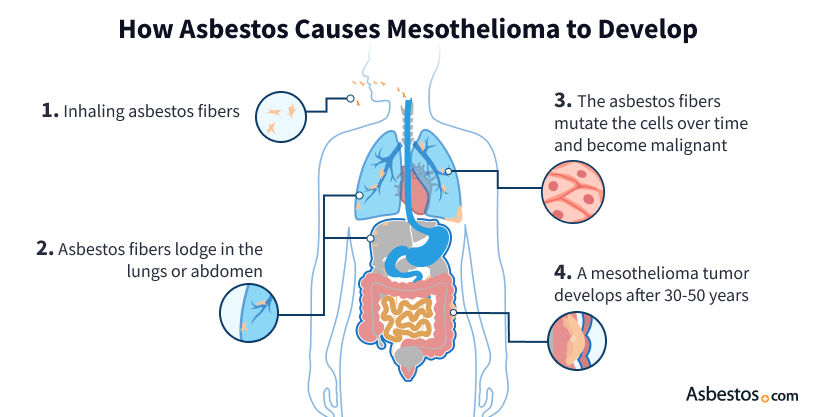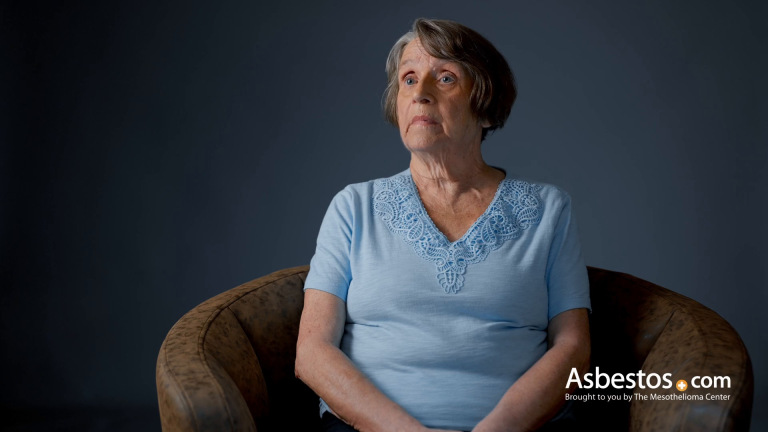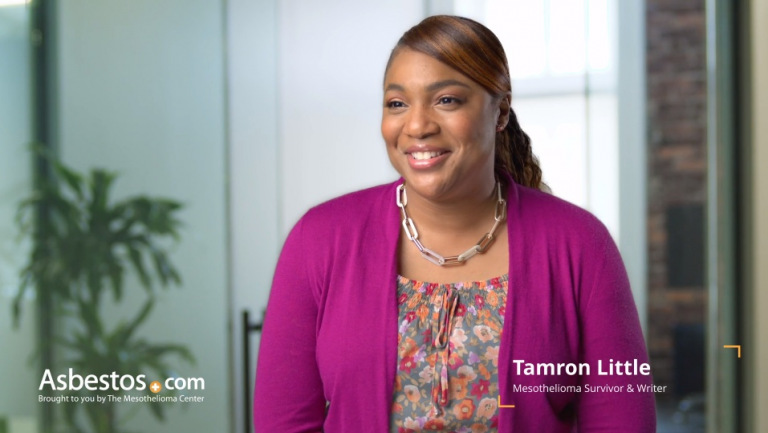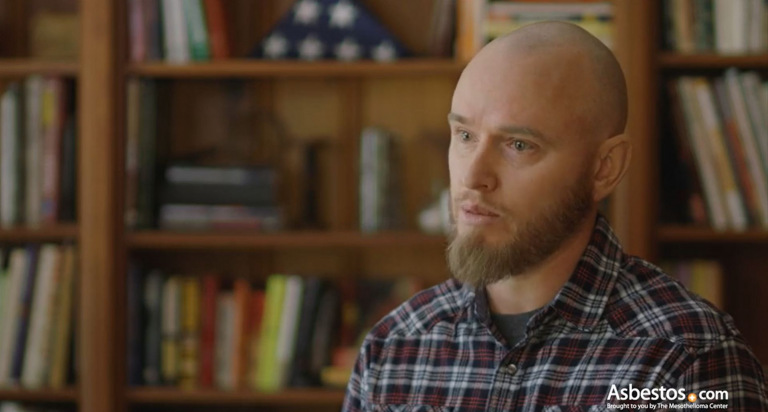John Conway worked as a Navy boiler technician when ships heavily used asbestos. He then worked for the Merchant Marines for 24 years. “I was proud to serve. It was fun, too. It took me around the world three times,” he told us. When I was stripping asbestos insulation from below-deck steam pipes it looked like it was snowing down there. I never thought about any long-range danger.
Mesothelioma Causes & Risk Factors
The primary cause of mesothelioma is asbestos. The asbestos fibers stick to the lining of the lungs and other organs, eventually causing mesothelioma. The main mesothelioma risk factor is asbestos exposure. Other risk factors for mesothelioma are occupational and secondhand exposure, age and gender.
What Causes Mesothelioma?
Asbestos exposure is the main cause of mesothelioma. Mesothelioma develops decades after microscopic asbestos fibers are inhaled or ingested. The fibers get trapped in a thin layer of tissue called the mesothelium. This smooth tissue lines the lungs, abdomen, heart and testes.
Key Facts About Mesothelioma Causes
- Out of all people with heavy, prolonged exposure to asbestos, 8% to 13% develop mesothelioma.
- Asbestos workers with years of exposure have the highest risk of developing mesothelioma.
- Because there is no safe amount of asbestos exposure, limited exposure can also cause mesothelioma.
Most mesothelioma cases are caused by asbestos exposure at work or in the military. Some people also develop mesothelioma because of secondhand contact. Workers have inadvertently brought asbestos home on their bodies, clothing or gear, exposing their families. Other risk factors can raise the chance of cancer in those exposed to asbestos. Other risk factors include family history, genetics and exposure to radiation.
DNA Damage Caused by Asbestos Fibers
DNA damage by asbestos begins when the fibers pierce the mesothelial lining. The fibers cause inflammation and damage to the mesothelial cells. This leads to irreversible scarring, DNA damage and cancer.
Asbestos fibers enter mesothelial cells, and the damage they cause disrupts the cells’ life cycle. Asbestos also produces free radicals that damage DNA and cause healthy cells to mutate. The fibers also trigger the production of oncoproteins. These proteins block genes that protect cells from growing uncontrollably and forming tumors. Over time, asbestos triggers multiple pathways that cause mesothelioma tumors to form.
The duration and intensity of asbestos exposure impacts how much DNA damage occurs. Higher exposure translates to a higher risk of developing mesothelioma. This is called a dose-response relationship. However, any amount of asbestos exposure can potentially lead to mesothelioma.

Mesothelioma Risk Factors
Asbestos exposure is the biggest risk factor for a mesothelioma cancer diagnosis. Risk factors are characteristics that increase the likelihood of developing a particular disease. Other risk factors include genetics, age, gender and other types of exposures.
Exposure to asbestos can occur in the workplace, older homes, public buildings and the environment. While many people know if they’ve been exposed to asbestos, others may not be aware of their exposure.
Key Facts About Mesothelioma Risk Factors
- Shipbuilders, steelworkers and construction workers face a high risk of asbestos exposure. Firefighters, auto mechanics, and building renovators and demolishers are also at high risk.
- Family members of asbestos workers have the highest risk for secondary exposure.
- A 2020 CDC report says people over 60 are 10 times more likely to develop mesothelioma than those under 40.
- Research shows genetic risk factors, such as a mutated BAP1 gene, increase the chances that a person will develop mesothelioma because of asbestos exposure.
There are several types of asbestos exposure: Occupational, military, secondary and environmental. Asbestos fibers were used in construction, auto parts and machinery for their heat resistance. But they can break down and create toxic dust. Home exposure happens when homeowners or others in the house encounter older construction products that use asbestos.
Raeleen Minchuk, a peritoneal mesothelioma survivor from Canada, was exposed to asbestos in her grandparent’s home. She was just a baby when her grandfather renovated his home. Raeleen crawled on the floor covered with asbestos dust. At the time, the public wasn’t aware of the dangers of asbestos.
Occupational Asbestos Exposure
Occupational asbestos exposure poses the highest risk of disease. Occupations at risk include miners, industrial, factory, manufacturing and textile mill workers. Shipyard, boiler and power plant workers also worked around many asbestos products. Construction workers and firefighters today encounter legacy asbestos when working in older buildings. The risk is high during renovation, demolition or disaster response.
Historically, men were more likely to have jobs with a greater risk of contact with asbestos. This has traditionally led to higher mesothelioma incidence rates in men than women. The U.S. Centers for Disease Control recently reported a sharp rise in mesothelioma cases in women.
Military Asbestos Exposure
Veterans also experience higher rates of mesothelioma because of asbestos exposure. Every branch of the military used asbestos extensively on bases and in vehicles, ships and planes.
The types of military jobs most at risk of asbestos exposure included boiler and maintenance technicians, pipefitters and shipyard workers. Civilians who lived in military bases were also exposed to asbestos.
Navy personnel faced the highest risk of exposure. Asbestos was used on ships because it reduced the spread of fire. It was also used in protective gear, like respirators and heat-resistant gloves, for operating gun turrets.
Retired Navy veteran John Conway worked as a boiler technician and remembers stripping asbestos insulation as part of his job. Decades later, John developed pleural mesothelioma. “It used to look like it was snowing down there,” John said of the airborne asbestos fibers.
Secondary Asbestos Exposure
Secondary exposure happens when someone carries asbestos fibers home. It gets carried on their skin, hair, clothing, footwear or tools. Those fibers could then spread into the air, putting those around them at risk of exposure. People with high-contact jobs with asbestos were most at risk. They could bring home fibers on their bodies, uniforms or work tools.
The widespread use of asbestos in many products puts thousands at risk for primary and secondary exposure. For example, barbers and ceramics workers used talc contaminated with asbestos. Bringing these fibers home caused cancer in many of their family members. Women and children are more likely to have secondary exposure.
My mesothelioma was caused by my father’s work clothes. He had been a lagger and worked with asbestos all through my childhood. He died of mesothelioma in 1989.
Environmental Asbestos Exposure
Living near large deposits of asbestos and asbestiform minerals like erionite risks exposure. Minimal amounts of microscopic fibers can linger in the air in these regions. This is most dangerous near former asbestos mines and manufacturing plants.
In June 2009, the U.S. Environmental Protection Agency declared a public health emergency in Libby, Montana. The hazard arose from an asbestos-contaminated vermiculite mine in the town. Thousands of Libby residents have been diagnosed with asbestos-related diseases, including mesothelioma.
The risk of disease from living near asbestos mines is lower than from working with asbestos. Research suggests that this may cause 3% of all mesothelioma cases and 19% of cases in women.
Get Your Free Mesothelioma Guide

Find a Top Mesothelioma Doctor

Access Help Paying for Treatment

Gender and Age
Men are more likely than women to develop mesothelioma. Mesothelioma occurred 2.4 times more often in men than in women in 2020. This is the most recent gender data from the U.S. Centers for Disease Control and Prevention and SEER. Of the genders, men are more likely to have occupational asbestos exposure. Women are more likely to be exposed to asbestos through contaminated talc used in talcum powder.
The CDC reported in 2020 that most people get diagnosed between ages 75 and 79. Mesothelioma risk increases with age because mesothelioma takes 20 to 60 years to develop after exposure. This does not mean that young people do not get mesothelioma from asbestos exposure. Cases of asbestos-related mesothelioma have occurred in teens and young adults in their 20s.
One piece of advice who I would give to a woman who has been recently diagnosed with mesothelioma is this. Let me encourage you for a moment. You have access to treatments, different treatments. You have the right to get a second opinion. You have the right to ask questions. You have the right to find the specialist who you want for your journey.
Family History and BAP1 Gene
Genetic factors can increase the risk of various types of cancer, including mesothelioma. Your risk of mesothelioma is higher if you have a family history of mesothelioma.
In most mesothelioma cases, specific mutations of a gene called BRCA-associated protein 1 (BAP1) exist in mesothelioma cancer cells. Mutations are simply variations of the typical DNA sequence of a gene. These mutations can be inherited from a parent or acquired during a person’s lifetime. Mesothelioma is not inherited, but if a person inherits this specific mutation, it will increase their risk of mesothelioma.
Simian Virus 40 & Radiation
Other risk factors include exposure to radiation and Simian Virus 40. Exposure to ionizing radiation may be a risk factor for mesothelioma. X-rays, gamma rays and other forms of ionizing radiation can increase the risk of different types of cancer. Exposure to high doses of radiation may be a risk factor for mesothelioma. Radiation therapy for cancer is an example. Low doses of radiation from X-rays, CT scans and occupational exposure are not risk factors.
Simian Virus 40 is a virus linked to several types of cancer, including mesothelioma. SV40 does not usually cause illness in humans and is not known to cause mesothelioma. However, research indicates that many mesothelioma cases show the presence of SV40 in cancer cells. Ongoing research will determine whether it is a risk factor for mesothelioma.
Who Is Most at Risk for Mesothelioma?
People who have worked in industries with significant occupational exposure to asbestos are at the highest risk for developing mesothelioma. This risk includes veterans and military personnel. Veterans account for 30% of new mesothelioma claims.
- High-Risk Careers: Construction workers, boiler workers, factory and industrial workers and firefighters, as well as those who work in power plants, shipyards, mines and textile mills.
- Veterans and Military Personnel: Military bases, housing, vehicles, and crafts, including planes and ships, once extensively used asbestos.
- Residents Near Environmental Asbestos: Living near natural asbestos deposits can result in asbestos exposure because of the disturbance of sediment and soil. This mostly affects those living near asbestos mines.
- Hobbyists and DIYers: While it is rare, working on automobiles and home renovations can lead to asbestos exposure and increased mesothelioma risk.
Workers in industries that use or have used asbestos are at the highest risk of mesothelioma. Mesothelioma is rare in hobbyists and DIYers, but any amount of asbestos exposure increases your risk of mesothelioma.

Gain access to top mesothelioma doctors and get help scheduling appointments.
Connect NowHow to Lower Your Risk of Mesothelioma
Preventing mesothelioma means reducing exposure to asbestos. It is the main cause of this cancer. Asbestos exposure at work is the main cause of this cancer. To prevent mesothelioma, we must follow asbestos workplace safety guidelines.
Tips to Reduce Asbestos Exposure
- Avoid wearing clothing, footwear and other work gear that could harbor asbestos fibers at home.
- Be careful when buying vintage, antique or upcycled items that may contain asbestos.
- Discuss your work history with your doctor. Schedule tests for early detection.
- Hire a reputable professional asbestos abatement company to test and remove asbestos from your home.
- Purchase talc-free cosmetics and personal care items.
- Talk to your employer about asbestos risks and the policies in place to mitigate those risks.
If you or a loved one has a history of asbestos exposure, talk to your doctor about screenings for mesothelioma. If you develop respiratory, abdominal or other mesothelioma symptoms, see your doctor right away. Initial symptoms of mesothelioma can include shortness of breath, chest pain or abdominal distress. Patient Advocates can help connect you with a specialist for a diagnosis, second opinion and specialized treatment.
- A 2023 study finds risks across jobs and asbestos types. The peritoneal mesothelioma rate for all jobs studied was 70 to several hundred fold higher for amosite and crocidolite.
- Patients and families should be aware of potential asbestos exposure risks, particularly in industries like textile work, construction, manufacturing and shipbuilding.
“Asbestos exposure is the primary cause of mesothelioma. Still, there is no predictability as to who or when the exposure will progress to the development of mesothelioma and where it will manifest in the body.”
Common Questions About Mesothelioma Causes
- How much exposure to asbestos will cause mesothelioma?
-
Most people with asbestos exposure will never develop mesothelioma. However, any asbestos exposure can cause mesothelioma. Chronic exposure carries the highest risk, but even a single exposure can lead to mesothelioma.
- How likely am I to develop mesothelioma?
-
Mesothelioma is a rare form of cancer. There are about 3,100 new cases per year in the U.S. There were 0.7 new cases per 100,000 people in 2018. Mesothelioma is very rare in people without any known asbestos exposure. High-risk occupations for asbestos exposure include construction, power generation, shipbuilding and industrial work.
- How long does it take for mesothelioma to develop?
-
Asbestos fibers turn healthy cells into cancer cells decades after exposure. The fibers initiate an inflammatory process that slowly causes genetic damage and eventually cancer 20 to 60 years later. Once tumors form, mesothelioma can quickly progress to stage 3 or 4 before causing symptoms.
- Does smoking cause mesothelioma?
-
No, smoking does not cause mesothelioma. The primary cause of mesothelioma is exposure to asbestos fibers. Smoking and tobacco use are linked to lung cancer and other cancers. But, they are not linked to a higher risk of mesothelioma.
Answered By: Anna Nowak, internationally renowned asbestos researcher and mesothelioma advocate.











